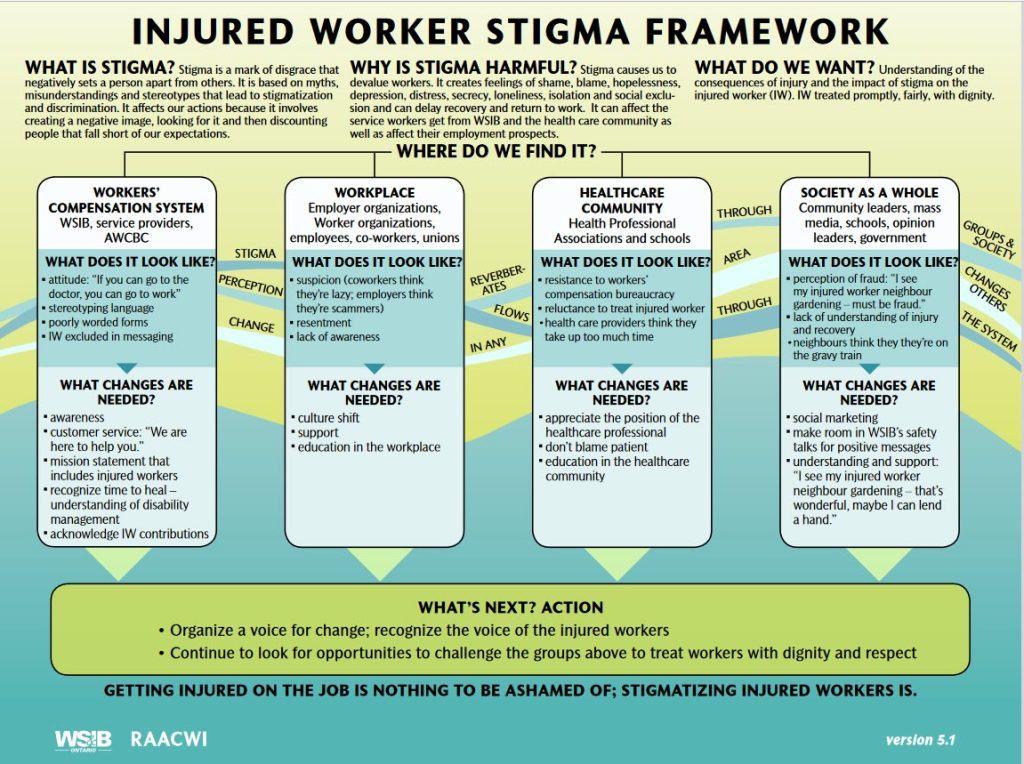Although it is their legal right, injured workers still find that filing a claim for the workers’ compensation can expose them to suspicion, hostile attitudes and behaviour of those around them – the WSIB , employers, doctors, colleagues, even neighbours – which compound the harm caused by their work-related injury.
Stigma happens when injured workers are unfairly judged on presumed moral worthiness and character. Some “blame the victim”, charging them with being careless workers rather than questioning if the employer has provided safe working conditions. Others doubt the legitimacy of their claim – especially if it is an invisible injury such as chronic pain from a musculoskeletal disorder or a psychological disability. They accuse them of “gaming the system” by faking or exaggerating symptoms to avoid work or personal responsibilities, collect “easy money” or some other benefit. Poverty, pain and unemployment rates among injured workers tell the real story.
Suspicion on top of injury
In recent years research into injured workers’ interactions with the workers’ compensation system and experiences with return to work has documented a too-frequent discourse of abuse that hurts health and personal wellbeing and delays recovery.
The treatment of injured workers and aggressive claims management can reflect institutional mistrust and cost containment priorities. In the workplace, employers and co-workers may regard injured workers as troublemakers, their need for time to heal or job accommodation resented and distrusted by those who feel burdened with extra work or costs.
In 2008 the Research Action Alliance on the Consequences of Work Injury (RAACWI) proposed an anti-stigma initiative to the WSIB. Over the next three years their joint project aimed to identify and research stigmatizing attitudes in the Board, workplace, healthcare system and community at large, and take concrete measures (staff training, communication programs) to improve interactions. While the initiative was a positive step forward, recent policies and practices at the Board have undermined the good intent.

- Popovic, Mila et al. 2025. Conceptualizing Stigma in the Injured Worker Literature. Journal of Occupational Rehabilitation Online Mar. 18
- Kilgour, Beth et al. 2015. “Interactions Between Injured Workers and Insurers in Workers’ Compensation Systems: A Systematic Review of Qualitative Research Literature.” Journal of Occupational Rehabilitation 25(1): 160-181.
- Warsi, Sheena. 2014. “Injured Workers and Stigma: An Interdisciplinary Analysis.” Athabasca: Athabasca University
- Lippel, Katherine. 2012. “Preserving workers’ dignity in compensation systems: an international perspective”. American Journal of Industrial Medicine 55: 519-536.
- Institute for Work & Health. 2010 Sep. WSIB Launches Anti-Stigma Initiative.
- Kirsh, Bonnie. 2009. “The Nature and Consequences of Stigma as Experienced by Injured Workers.” Presentation at the RAACWI Community Forum, Toronto, April 29.
- Eakin, Joan M. 2005. “The discourse of abuse in return-to-work: A hidden epidemic of suffering.” In Occupational Health and Safety: International Influences and the New Epidemics, edited by Chris L. Peterson and Claire Mayhew, ch. 9, 159-174. Amityville, NY: Baywood Publishing


